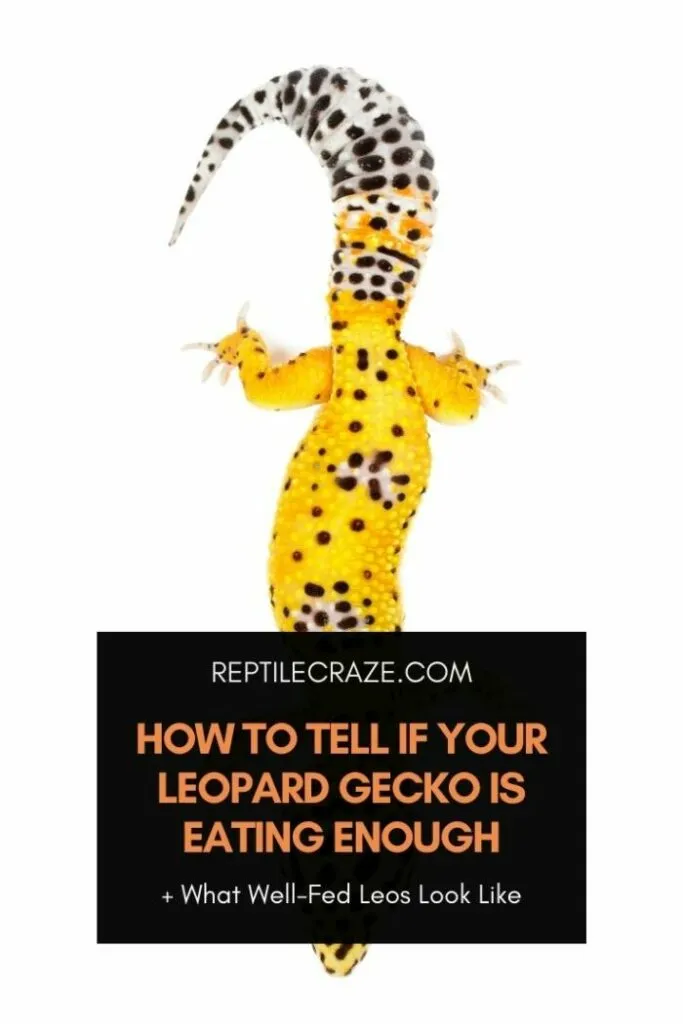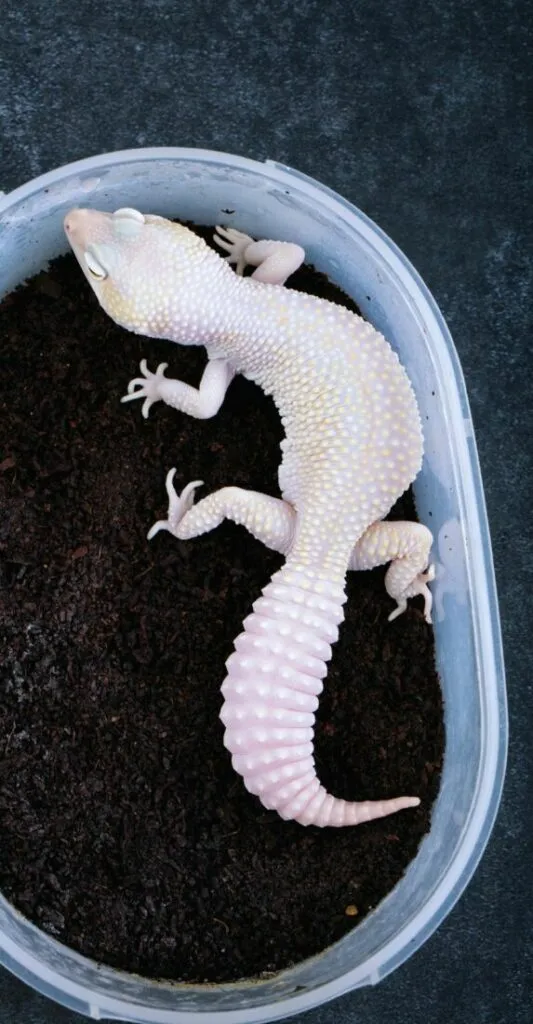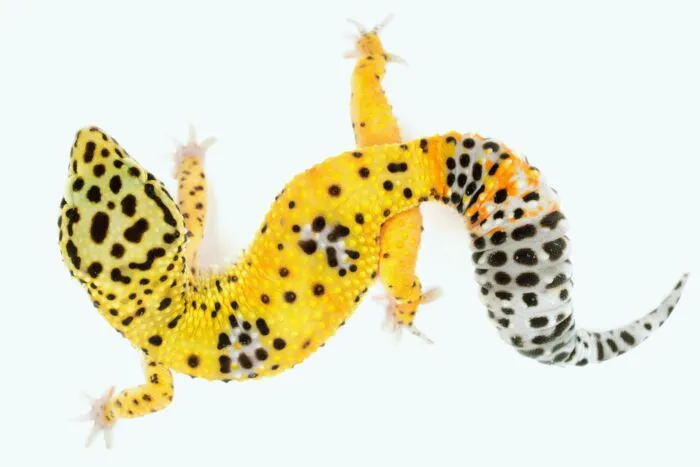
First-time and even long-time owners of leopard geckos are consistently wondering if they are feeding their leos enough. This is understandable as we want to know if they are having their fill or if we need to adjust the amount of
The most obvious sign that a leopard gecko is eating enough is when it has a plump tail. Other signs include keenness to eat and drink, plumping of the body, basking under heat, and having healthy-looking skin.
If you are not sure if you are feeding your leo enough, then this is the read for you! We are going to talk about the signs that show that your leos are eating enough and properly. There will be no skinny or obese leos on our watch, so read on!
Table of Contents
Signs That Your Leopard Gecko Is Eating Enough
You cannot conclude that your leopard gecko is eating properly based on the fact that it was able to eat all of the feeders that you offered. Further, it is also bad practice to attempt to offer more feeders just to see if your leo would want to eat more.
This is the reason why looking at certain signs will give you a concrete answer if your leopard gecko is living a healthy life, at least in terms of eating. Let us take a look at them.
Fat Tail
This is the easiest way to find out if your leopard gecko is eating enough. Just take a look at their tail and determine if they are fat or plump enough.
The reason behind this is that the tail is where leopard geckos store fat and water. Their bodies are simply made this way. In this way, they have enough stores to “power” their body in the event that they cannot eat regularly or in case of illnesses that force them to not have any appetite.
Keep in mind that these stores are not necessarily from excess fat and water. A lot of researchers believe that a portion of the present

To further support this claim, it was observed that leos that are in captivity tend to slow down the fattening of their tail as opposed to leos in the wild where the main priority of their body is to store as much fat and water in their tails.
Note: The reason behind this is that leos in captivity have a feeding schedule and eventually their body adjusts to that lifestyle and becomes a bit lax in prioritizing stores in the tail. As opposed to leopard geckos in the wild where they do not know when they can feed again.
What does this mean for us? It simply means that if your leo has a plump or even slightly fat tail, it is fed enough. On the other hand, if the tail is too thin, then your leo is suffering from something serious that can cost its life. So keep an eye on that tail!
Keenness To Eating And Drinking
You might think that if your leopard gecko is still hungry when it is always open to eating and drinking. But the truth is, it may have already had its fill, but it is still accepting your offerings in an effort to fill up its stores or it just enjoys eating.
If you adhere to a strict feeding schedule as well as times when they get to eat special treats, your leo will eventually learn its expected feeding pattern.
In turn, its metabolic cycle knows when to amp up or wind down. Therefore, when you feed your leo outside of the designated time, it is more than open to eat as the digestion process was already over.
More than that, if you observe that your leo is drinking water regularly, that is also a sign of being healthy. They need heat to digest and it can also make them thirsty. So in order to aid the process and not get dehydrated along the way, they will drink more water.
Important note: Sometimes, leopard geckos even stop eating for days or weeks when they have stored enough energy. Therefore, this also means that they have eaten enough. To be safe, make sure to check if there are any other reasons as to why they are not eating ie; impaction or parasites.
Utilizing Heat
The enclosure of your leopard gecko should have a cool and warm side. Let us concentrate on the warm side. This can be in a form of a heat lamp or any other source of heat.
This is essential as heat plays a huge part in proper digestion. When your leopard gecko is done eating, you may notice that it will stay on the warm side of the enclosure. The reason is that it is utilizing heat to digest its meal properly.
Therefore, if you notice that your leopard gecko is not really using heat to its advantage after a feeding session, then it does not have enough
Plump Body
Another easy way to find out if your leopard gecko is eating enough is they have a plump body. Keep in mind that this sign is an indication of good health, however, this can also be a sign of an impaction or egg binding.
Info: In order to make sure that its plumpness is normal, hold your leo and feel his belly. If it is squishy and you do not feel anything hard or anything irregular in terms of shape, then the plumpness is caused by healthy eating.
When we talk about a healthy plump look it should have the following characteristics:
- The bulge visibly looks round
- It should also look full
- Does not have any gaps

Overfeeding is possible in leopard geckos, and just like human obesity can also be dangerous for them. So you have to assess the plumpness of your leo’s body carefully so you can discern whether it is a sign of health or a sign of overfeeding.

Healthy Skin
It is funny to think that just like humans, an indication of eating enough and properly is also healthy-looking skin in leopard geckos. With this sign, you cannot only find out if you are feeding your leo enough, but their skin also gives a clue if they are getting proper nutrition.
Here are the indications of healthy skin:
- Does not look too dry
- No signs of patching and parasites
- Tail is soft
- Regularly sheds
If these characteristics are present, it is also an indication that the calcium and phosphorus levels are equal in your leo’s system.
The Right Weight Of Leopard Geckos
Take a look at the chart below to guide your feeding amount and schedule as well as the proper monitoring of the weight of your leopard gecko. Remember that you should measure the weight and length of your leo’s body to make sure that you are caring for it properly.
| Age | Approx. Weight | Feeding Frequency | Amount of |
| 0-6 months | 0-15 g and 15-30 g | Daily | As much as they can eat in 15 mins. |
| 6-12 months | 30-60 g | Every other day | As much as they can eat in 15 mins. |
| 12+ months | 40-110 g | Every two to three days | Two insects per inch of your leo’s body length |
Conclusion
You do not need to worry if you feel like you are not feeding your leopard gecko enough. The most important thing to remember is to have a fixed regular feeding schedule.
In this way, even though you may have made a mistake in one feeding and left your leo wanting more, it still has enough stores in its tail to make up for that mistake.
So relax! Just as long as you have observed the signs that we discussed in your leo, it is more than happy and healthy in its enclosure.
- Eastern Rat Snake: Nature’s Pest Control and Fascinating Reptile - September 20, 2024
- Eastern Racer: The Fast and Agile Snake - September 19, 2024
- The Eastern Indigo Snake: The Majestic, Non-Venomous Hunter of the Southeast - September 18, 2024
